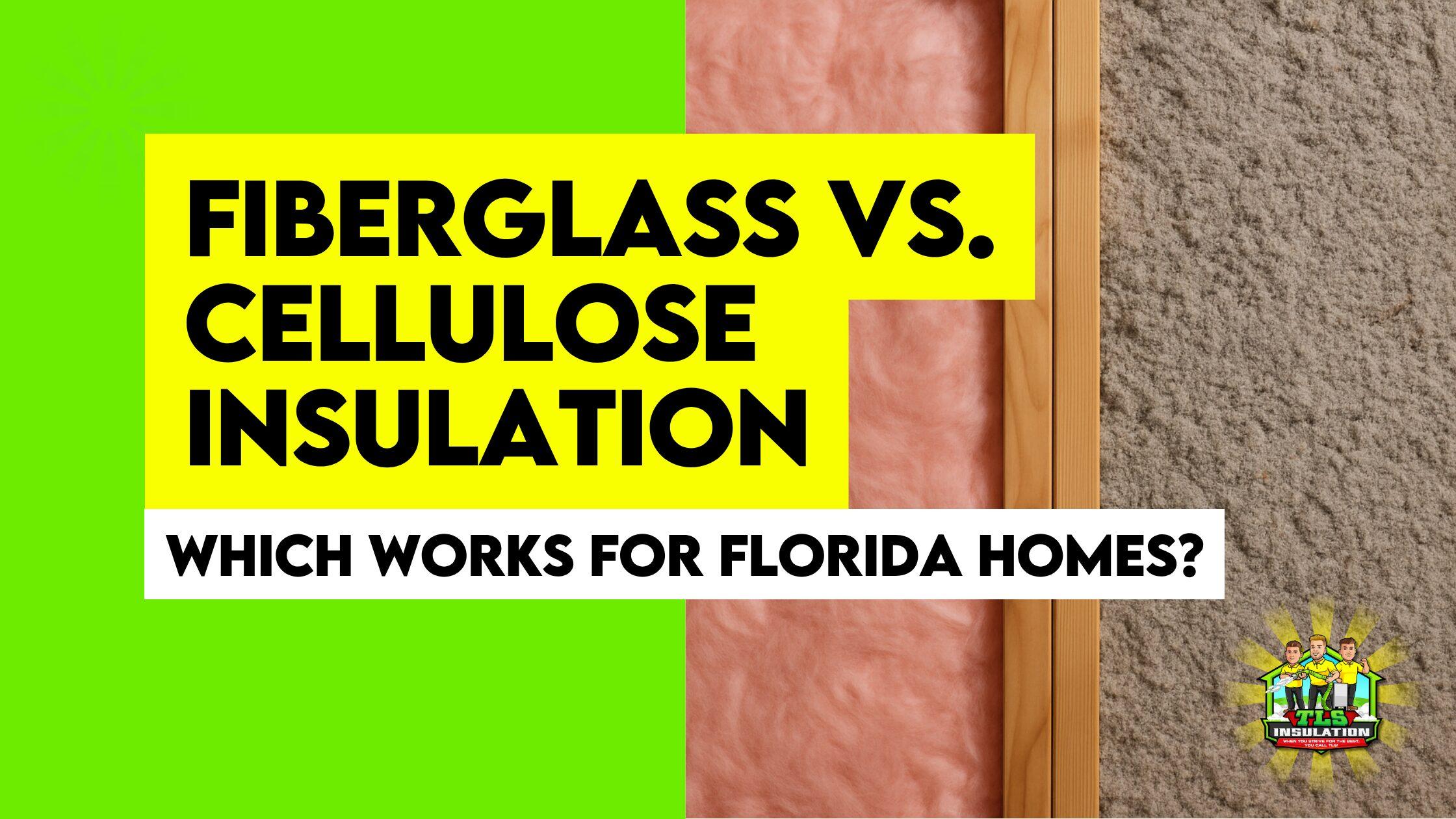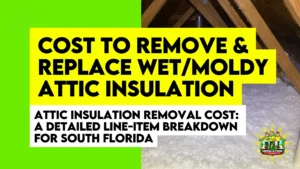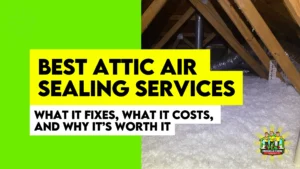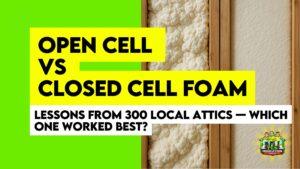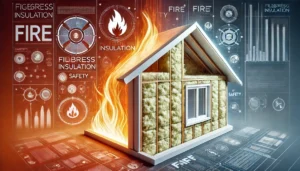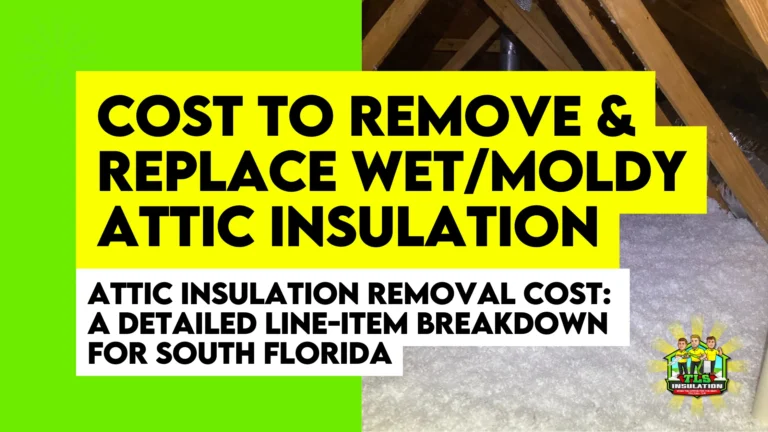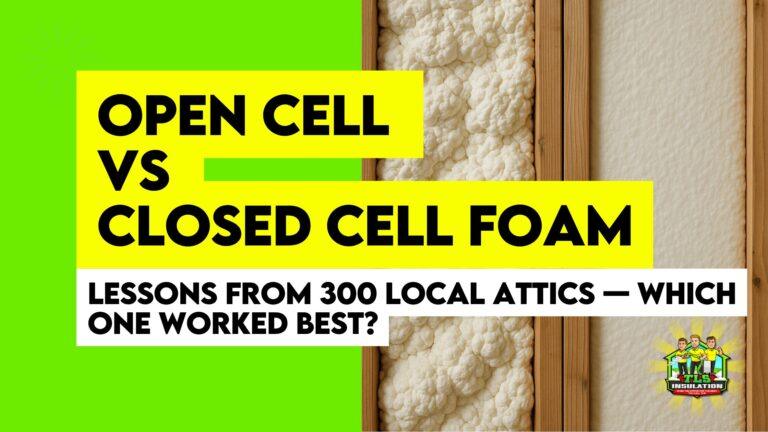When exploring fiberglass vs. cellulose insulation, you’re choosing between two great options for your Florida home.
Fiberglass insulation, made from spun glass, costs $0.85-$1.20 per square foot and offers an R-value of 2.2-2.7 per inch. Cellulose insulation, crafted from recycled paper, is priced at $0.95-$1.40 per square foot but provides a higher R-value of 3.2-3.8 per inch, ideal for Florida’s hot summers.
In Miami or Tampa, where high energy bills hit hard, fiberglass is popular. Approximately, it is being used in 80% of homes for its moisture resistance and easy insulation installation.
Meanwhile, cellulose is gaining traction among homeowners seeking eco-friendly insulation. It’s made from up to 85% recycled materials and requires less energy to manufacture, a big plus for those in Florida, where moisture resistance is key.
But then, both tackle Florida’s humidity and hurricane-prone weather, boosting energy savings. Let’s see which fits your Florida home insulation needs best!
Understanding Material Composition and Environmental Impact
When comparing fiberglass vs. cellulose insulation, think of them as two unique recipes for making your Florida home comfy and energy-efficient.
Fiberglass insulation is like a cozy blanket woven from super-thin glass threads, perfect for attic insulation or wall insulation. Cellulose insulation, on the other hand, feels like a dense layer of treated recycled paper which makes it ideal for blown-in insulation.
These differences impact insulation installation, thermal resistance, and how they handle Florida’s high humidity.
For environmental impact, cellulose insulation shines. It’s made from 85% recycled newspapers and cardboard, using 20-40% less energy to produce, which appeals to eco-friendly homeowners in Miami or Sarasota.
However, fiberglass insulation requires melting sand at 2,500°F, consuming more energy and increasing its carbon footprint. In Florida’s climate, where sustainable insulation matters, cellulose supports green building practices while keeping energy bills low. On the other hand, fiberglass is the name of absolute practicality and a good value to money.
FiberGlass vs Cellulose Blown Insulation Cost and Performance Comparison
| Factor | Fiberglass | Cellulose |
| R-Value per inch | 2.2-2.5 | 3.2-3.8 |
| Cost per sq ft | $0.85-$1.20 | $0.95-$1.40 |
| Installation time | Faster (less labor-intensive) | Moderate (requires more effort) |
| Sound dampening | Good | Excellent |
| Fire resistance | Good (meets building codes)** | Better (fire retardants added)** |
| Pest resistance | Moderate | Excellent (due to natural resistance) |
| Lifespan (years) | 25-40 | 20-30 |
| Air sealing | Good (adequate for most homes)** | Excellent (great for air-tight homes)** |
Cellulose or Fiberglass Insulation: Which Has Better Installation Methods and Practical Applications?
When choosing between cellulose vs fiberglass blown-in insulation, the installation method plays a crucial role in determining the best fit for your home. Both materials offer distinct advantages depending on the application and the specifics of your home’s structure.
Blown-in Application
Note: Either Fiberglass or Cellulose, Both performance depends on a high-end blown insulation installation.
Cellulose insulation excels in blown-in application due to its ability to fill every nook and cranny with a dense, tightly packed barrier. This results in superior air sealing and effective blockage of air movement, which is especially important for homes in Florida, where high humidity and heat resistance are critical.
But the cost of blown-in insulation with cellulose is somewhat high from fiberglass.
The blown-in process also helps reduce cooling costs by minimizing air leaks in hard-to-reach areas like attics and walls. Cellulose, made from recycled paper products, settles into place and creates an efficient insulation layer with excellent moisture resistance, ideal for Florida’s humid climate.
On the other hand, fiberglass insulation can also be blown in, but it typically doesn’t achieve the same level of density or uniform coverage as cellulose insulation. While it is still a good option for insulation in Florida homes, fiberglass blown-in insulation may leave small gaps and less effective air sealing compared to cellulose.
Batt Installation
For batt installation, fiberglass dominates, thanks to its pre-cut batts designed to fit standard wall cavities. While installing fiberglass batts can be more time-consuming, they provide consistent coverage when installed correctly.
However, precision is important as improperly cut batts can leave gaps around areas like electrical boxes and pipes, which can reduce overall insulation performance. In Florida, ensuring the batt is fitted snugly is vital for achieving maximum energy efficiency in homes, especially in attics and walls exposed to intense summer heat..
The Utility Difference Between FIberglass and Cellulose
| Area | Fiberglass Insulation | Cellulose Insulation |
| Attic | Best choice for Florida due to affordability, good air sealing, and ease of installation. Effective in hot, humid climates but needs proper vapor barrier to prevent moisture issues. | Works well for energy-efficient homes, especially with its superior moisture resistance. Great for cooling cost savings, but can settle over time, reducing effectiveness unless topped up. |
| Walls | Effective for standard wall cavities. Fiberglass batts provide consistent coverage but may leave gaps around electrical boxes and pipes unless installed carefully. | Great for walls in coastal areas, where moisture resistance is key. Blown-in cellulose fills gaps better and prevents air leaks, offering better insulation performance over time. |
| Ceiling | Ideal for ceilings due to its heat resistance. Can be used in both attics and ceiling spaces in homes to improve cooling efficiency in Florida. | Performs similarly but offers better air sealing. Ideal for homes with air-tight ceilings but requires periodic top-ups due to settling. |
| Crawlspaces | Works well if installed with vapor barriers to prevent moisture damage. Fiberglass batts or blown-in fiberglass are effective, especially in Florida crawlspaces exposed to humidity. | Better for crawlspaces due to superior moisture resistance. Helps keep moisture at bay in humid Florida climates, but settling can be an issue in areas prone to water exposure. |
| Basements | Works effectively in basements where moisture control is critical. Needs proper sealing to avoid moisture-related issues. | Performs better in basements, especially if moisture control is required. The moisture resistance of cellulose is crucial for Florida basements prone to humidity. |
| Basement Walls | Fiberglass batt insulation works well but requires careful installation to prevent air leaks. Good in dry areas. | Blown-in cellulose is ideal for basement walls as it fills cavities and provides better thermal resistance and moisture control. Great for areas exposed to high moisture. |
| Floors | Fiberglass is often used in floor insulation for its affordability and ability to withstand temperature changes. Works well when installed with proper air sealing. | Cellulose is effective for floor insulation when dealing with moisture concerns. It is especially useful in crawlspaces or homes where high humidity is a problem. |
Cellulose vs Fiberglass Climate-Specific Performance Analysis
Florida’s Unique Challenges
Florida’s high humidity (70-80%) and hot summers demand moisture-resistant insulation. Thunderstorms in Tampa or Sarasota risk water intrusion, while salt air in Miami tests durability.
Fiberglass insulation excels with mold resistance, perfect for Jacksonville homes. Cellulose insulation, treated for fire resistance, also fights moisture, supporting energy-efficient homes in Florida.
- Average humidity levels of 70-80% year-round create constant moisture concerns
- Summer temperatures regularly exceeding 90°F test insulation’s heat resistance
- Frequent afternoon thunderstorms increase the risk of water intrusion
- Salt air in coastal regions can affect insulation performance over time
Hot Humid Climates
Coastal Florida Performance
In Miami, Tampa, and Daytona Beach, coastal humidity demands tough insulation. Fiberglass insulation, especially specially treated types, matches cellulose in moisture resistance while staying affordable, making it a top choice for Florida insulation contractors.
- Cellulose with borate treatment shows 25% better moisture resistance than standard fiberglass
- Specially treated fiberglass designed for humid climates performs similarly to cellulose, but costs 15-20% more
- Both materials require careful installation with vapor barriers facing the living space
- Studies show cellulose in coastal homes maintains R-value 30% better over five years
Central Florida Considerations
Orlando and Lakeland face attic temperatures over 130°F. Fiberglass insulation offers reliable R-value and fire resistance, saving cooling costs for attic and walls with easy insulation installation. Cellulose also performs well, cutting energy bills.
- Higher attic temperatures (often exceeding 130°F) affect both materials differently
- Cellulose maintains consistent performance despite temperature fluctuations
- Fiberglass can lose up to 50% of its R-value when attic temperatures peak, but when installed properly, it still offers solid heat resistance and energy efficiency.
- Local energy audits show homes with cellulose insulation save 15-20% more on cooling costs
Cold and Dry Climates
Northern Regions
In cold states like Minnesota or Maine, insulation battles freezing temperatures. Fiberglass insulation, with pre-cut batts, is a reliable choice for insulation contractors, offering fire resistance and easy insulation installation. When paired with air sealing, it performs strongly. Cellulose insulation also excels, reducing heat loss in energy-efficient homes.
- Cellulose’s density helps prevent up to 40% more heat loss
- Fiberglass batts can allow more air movement, reducing efficiency by 25-30%
- Both materials require careful attention to vapor barrier placement
- Wind washing affects fiberglass more severely in cold climates
Mixed Climate Zones
In transitional areas like the Carolinas, insulation must handle temperature fluctuations, much like Tallahassee or Gainesville in North Florida. Fiberglass insulation shines with moisture-resistant properties and affordability, making it a favorite for Jacksonville insulation services. Cellulose adapts well too, supporting HVAC efficiency during seasonal shifts.
- Both materials need to handle seasonal temperature swings
- Cellulose shows better adaptability to temperature changes
- Fiberglass performs well when combined with proper air sealing
- Moisture management becomes crucial during shoulder seasons
This insight helps Florida homeowners appreciate fiberglass and cellulose for attic insulation or wall insulation, ensuring cooling cost reduction even in milder Florida winters
Long-Term Cost and Maintenance: Fiberglass vs. Cellulose in Florida
When choosing what is better, cellulose or fiberglass insulation for your Florida home, long-term cost of insulation in Florida and maintenance matter. Both fiberglass insulation and cellulose insulation offer energy savings and durability, but they shine differently in Florida’s high humidity and hot summers.
Here’s how they compare for Miami, Tampa, or Orlando homeowners.
Energy Savings
Fiberglass insulation is a cost-effective choice, delivering solid cooling cost reduction for energy-efficient homes in Florida. Cellulose insulation saves slightly more, but fiberglass is easier to install, lowering upfront costs. Florida insulation contractors in Sarasota or Boca Raton recommend fiberglass for its reliability in HVAC efficiency.
- Over a 10-year period, cellulose typically saves 20-30% on energy bills compared to fiberglass
- Initial cost of insulation installation in Florida difference usually pays back within 2-3 years
- Better air sealing with cellulose contributes to higher savings
Durability and Maintenance
Both fiberglass and cellulose insulation last 20-30 years in Florida’s climate, making them great for attic insulation or wall insulation. Fiberglass is low-maintenance and moisture-resistant, perfect for mold prevention in Jacksonville. Cellulose may need occasional checks, but both thrive with proper care, as advised by Tampa insulation services.
- Cellulose may settle 20% over time, requiring occasional top-ups
- Fiberglass generally maintains its shape but can trap dust
- Both require proper moisture control to prevent degradation
For Florida homeowners, fiberglass insulation offers affordability and durability, while cellulose boosts energy savings, ensuring comfort in Central Florida or South Florida.
FAQs: Fiberglass vs. Cellulose Insulation for Florida Homes
Which insulation is better for soundproofing, fiberglass or cellulose?
Cellulose insulation offers better soundproof insulation due to its higher density and gap-filling in Florida homes. Tests show it reduces sound by up to 44% more than fiberglass insulation. However, fiberglass still provides solid soundproofing for Miami or Tampa homes, especially in attic insulation, ensuring indoor comfort.
Does cellulose insulation really settle over time, and is this a problem?
Yes, cellulose insulation settles about 20% over its lifetime in Florida’s climate. Licensed insulation installers in Florida, like those in Orlando, use dense-pack cellulose to minimize impact. When installed properly, settling doesn’t harm energy-efficient homes or thermal resistance.
How do these insulation types affect indoor air quality?
Both fiberglass and cellulose insulation are safe for Florida home insulation when installed correctly. Cellulose contains borate, resisting mold and pests in South Florida’s high humidity. Fiberglass insulation, used in Sarasota, may release particles during insulation installation, but Florida insulation contractors use safety gear to ensure clean indoor air quality.
Which type of insulation is more fire-resistant?
Cellulose insulation has strong fire resistance thanks to borate treatment, suppressing flames in Jacksonville homes. Fiberglass insulation is naturally non-combustible, offering excellent fire safety for Boca Raton properties, making it a reliable choice for hurricane-proof insulation.
How long does each type of insulation typically last?
Both fiberglass and cellulose insulation last 20-30 years in Central Florida when maintained. Moisture control in Tampa insulation services ensures longevity. Lifespan depends on quality insulation installation and Florida’s humidity, not just material choice.


